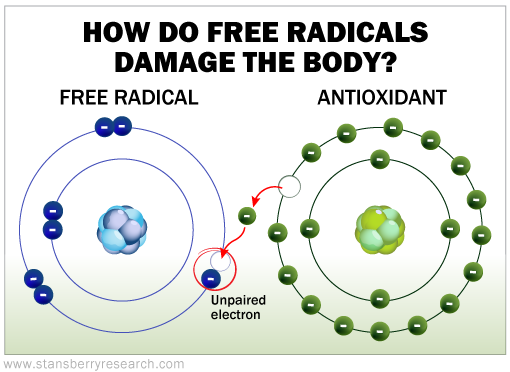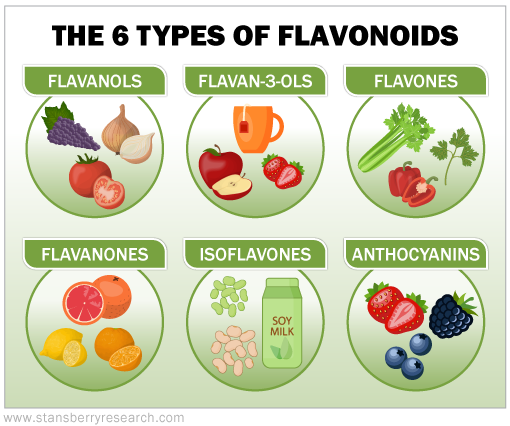What color is your diet?
Take a moment and think about what you eat every day... What's the predominant color of the food?
If you're American, it's probably some shade of brown. And that's a major problem for our health.
Several surveys show that 90% of Americans lack nearly every color of phytonutrients (chemical compounds found in plants) – green, white, red, yellow, orange, blue, and purple.
Each color has its own health benefits...
Purple in plants, like in red-leaf lettuce for example, comes from something called anthocyanins – which are a type of flavonoid (which we'll discuss further in just a moment). Carrots get their orange color from an antioxidant nutrient called beta-carotene, which metabolizes into vitamin A in the gut. An antioxidant called violaxanthin is responsible for giving some bell peppers their yellowish hue... and the antioxidant capsanthin makes other peppers red. Violaxanthin protects plants from light damage and capsanthin helps protect us against tumors.
Eating colorful plants every day is a great way to keep your body fed with the right stuff.
And today, I want to tell you more about flavonoids. Flavonoids are the most abundant polyphenol. Longtime readers know polyphenols are antioxidants that neutralize free radicals, reducing inflammation.
If the amount of free radicals is greater than the amount of antioxidants in your body, this leads to something called oxidative stress – which can damage your DNA and lead to cell death. Oxidative stress can also increase your risk of developing heart disease and certain forms of cancer.
So, eating antioxidants –like flavonoids –is thought to keep your free radicals balanced and your body healthy.
Flavonoids are found in a huge variety of fruits and vegetables... They even make their way into treats like tea, wine, and chocolate.
And one of the most beneficial things about flavonoids comes from some newly uncovered research...
It turns out that eating flavonoids helps protect you against cognitive decline, like Alzheimer's and dementia. This is according to a longitudinal study lasting nearly 25 years, which was published last year in the American Academy of Neurology journal.
The researchers looked at the diets of 75,000 participants aged 50 (at the start of the study) who are now in their 70s and 80s.
Of the participants, those who ate about 600 milligrams of flavonoids (or 0.02 ounces) per day had 20% lower risk of cognitive decline than those who only ate 150 mg (or 0.005 oz) per day. You could get more than 300 milligrams of flavonoids with just one cup of green tea.
Damage to the blood supply in the brain is a huge contributor to cognitive decline. When someone experiences a blockage in that blood supply, it's called an ischemia. Once the ischemia clears and the affected tissues regain their supply of blood, free radicals are formed.
A free radical is an atom that is unstable (meaning the atom has an outer shell with an incomplete amount of electrons) and will therefore take an electron from the outer shell of another atom. This causes the other atom to transform into another free radical. It then pulls an electron from another atom... and a chain reaction has begun.

This chain reaction eventually leads to the breakdown of the cell's membrane, meaning the things that travel in and out of the cell can change.
Having some free radicals is important for the healthy functioning of your body. The anti-inflammatory properties found in flavonoids help to protect that brain blood supply by balancing out the number of free radicals in the body. This ultimately slows cognitive decline.
Besides protecting you from cognitive decline, flavonoids also offer us:
- Cancer prevention (breast, prostate, colorectal, and lung)
- Management of chronic pain and inflammation
- Treatment of viral infections (H1N1, flu, SARS, RSV)
- Protection from cardiovascular disease and diabetes
All of these benefits are the result of the flavonoid's anti-inflammatory qualities. Chronic inflammation can create problems like cancer, heart disease, Alzheimer's disease, obesity, type 2 diabetes, and arthritis.
When your body fights off chronic inflammation by utilizing the antioxidant power of free radicals, you can avoid such diseases and illnesses.
There are six different types of flavonoids, each offering their own unique benefits...

1. Flavanols are particularly good for managing symptoms of cardiovascular disease. Foods like onions, grapes, tomatoes, kale, and broccoli are loaded with flavanols.
2. Flavan-3-ols improve endothelial function, lower blood pressure, and improve insulin resistance. Teas – like green, white, black, and oolong – contain flavan-3-ols. As do strawberries, apples, and cocoa.
3. Flavones are powerful inflammation fighters. Celery, parsley, red peppers, chamomile, and peppermint are some of the best sources of flavones.
4. Flavanones improve cardiovascular health, help with relaxation, and improve overall antioxidant and anti-inflammatory activity. Citrus fruits like lemons, limes, oranges, and grapefruit contain lots of flavanones.
5. Isoflavones may be beneficial in lowering the risk of hormonal cancers (like breast, endometrial, and prostate). These are also being studied as a treatment for menopausal symptoms. Look for isoflavones in soy, legumes (like chickpeas), currants, peanuts, and pistachios.
6. Anthocyanins help with heart health and lower your risk of obesity and diabetes. This antioxidant is found in red and purple grapes, blueberries, strawberries, cranberries, and blackberries.
Do what I do and get your flavonoids by striving to eat a rainbow of fruits and vegetables. Remember that each color offers a unique blend of antioxidant nutrients to keep you healthy – like beta-carotene and capsanthin...
Today, I had blueberries, peaches, and strawberries... Last night was tomatoes, scallions, broccoli, onions, and red peppers.
My health and wellness researcher is an avid cookbook collector. She enjoys hunting down high-flavonoid recipes and then putting her favorite recipes in a scrapbook. This gives her a convenient go-to resource for healthy recipes that she already knows she enjoys.
In following her footsteps, you could create a resource that ensures you'll get the most out of your flavonoids. The key will be to shop by color, looking for things on the list above as well... like green tea and dark chocolates.
What's a good recipe you could use for goji berries, orange peel, and rosehips? How about this flavonoid-packed recipe for a sugar-free jam substitute: Flavonoid Bomb.
Happy recipe hunting! And don't forget to share some of your favorites with us by sending them to [email protected]. (We may even put them in our own flavonoid cooking guide.)
What We're Interneting...
- Eating foods high in flavonoids could slow cognitive decline.
- Something different: The new technology helping athletes go faster, higher, and farther.
Here's to our health, wealth, and a great retirement,
Dr. David Eifrig and the Health & Wealth Bulletin Research Team
August 31, 2021
